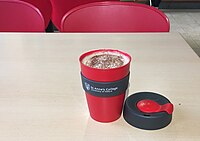
Photo from wikipedia
Large volumes of engineered wood products (EWPs) and paper are routinely placed in landfills in Australia, where they are assumed to decay. However, the extent of decay for EWPs is… Click to show full abstract
Large volumes of engineered wood products (EWPs) and paper are routinely placed in landfills in Australia, where they are assumed to decay. However, the extent of decay for EWPs is not well-known. This study reports carbon loss from EWPs and paper buried in landfills in Sydney, Brisbane and Cairns in Australia, located in temperate, subtropical and tropical climates, respectively. The influence of pulp type (mechanical and chemical) and landfill type (municipal solid waste - MSW and construction and demolition - C&D) on decay levels were investigated. Carbon loss for EWPs ranged from 0.6 to 9.0%; though there is some uncertainty in these values due to limitations associated with sourcing appropriate controls. Carbon loss for paper products ranged from 0 to 58.9%. Papers produced from predominantly mechanical pulps generally had lower levels of decay than those produced via chemical or partly chemical processes. Typically, decay levels for paper products were highest for the tropical Cairns landfill, suggesting that climate may be a significant factor to be considered when estimating emissions from paper in landfills. For EWPs, regardless of the landfill type and climate, carbon losses were low, confirming results from previous laboratory studies. Lower carbon losses were observed for EWP and paper excavated from the Sydney C&D landfill, compared with the Sydney MSW landfill, confirming the hypothesis that conditions in C&D landfills are less favourable for decay. These results have implications for greenhouse gas inventory estimations, as carbon losses for EWPs were lower than the commonly assumed values of 23% (US EPA) and 50% (Intergovernmental Panel on Climate Change). For paper types, we suggest that separate decay factors should be used for papers dominated by mechanical pulp and those produced from mostly chemical pulps, and also for papers buried in tropical or more temperate climates.
Journal Title: Waste management
Year Published: 2018
Link to full text (if available)
Share on Social Media: Sign Up to like & get
recommendations!